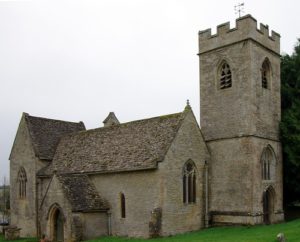Asthall is a small sleepy village of very large stone manor houses on the River Windrush. The church surrounded by it’s churchyard with roll top tombs, is set on the higher ground to the west of the settlement. It is a typical small village church built by the Normans and enlarged in the 14th and 15thC.
Inside, there is a Norman arcade with carved capitals between the nave and north aisle. The chancel arch has beakhead carvings round the outside. At the back of the church is a big round Norman tub font and the remains of the clock mechanism dating from 1670.
At the end of the north aisle is a small chantry chapel with the tomb of Lady Joan Cornwall set under an elaborate ogee arch. The window contains some fragments of Medieval glass with the Cornwall arms. On the floor are old grave slabs. In the corner is a piscina and small stone altar. A low stone screen separates it from the chancel.
The chancel has a simple altar and altar rail. The walls were painted by the Victorians with images of Old Testament characters set inside circles. Between them are smaller circles with IHS or fleur de lys. Round the top of the east window are painted angels. The gold paint shines in the sunlight. The roof panels have flower motifs and big carved corbels at the ends of the beams. There is a painted frieze round the base of the ceiling. There are no choir stalls, just two chairs for the celebrants.
Above the arch into the north chantry chapel is a painting of Gabriel holding a banner “Hail, thou art highly favoured…. The top of the arch cuts through the rest of the inscription, which continues as “Lord unto thee by Mary’ with the figure of the Virgin and Child.
On the south wall is a large memorial to William Arthur Bayford Kirwan-Ward, only son of the Vicar, who died in 1915 and was buried at sea off Cape Helles.
The church is open daily and there is parking on the road by the church.








